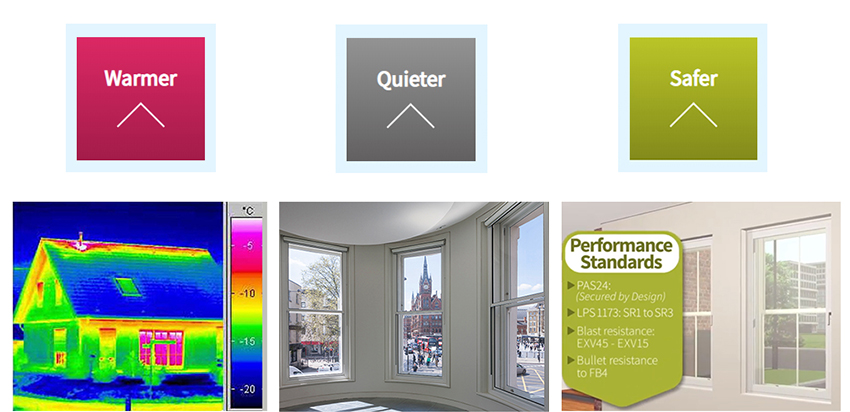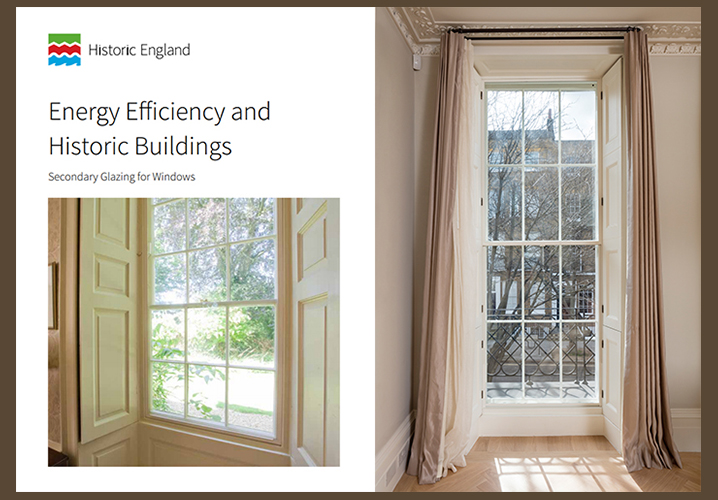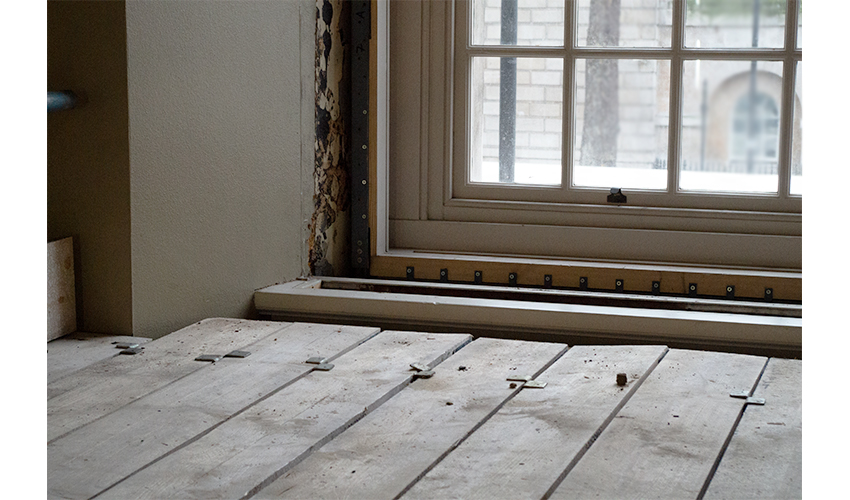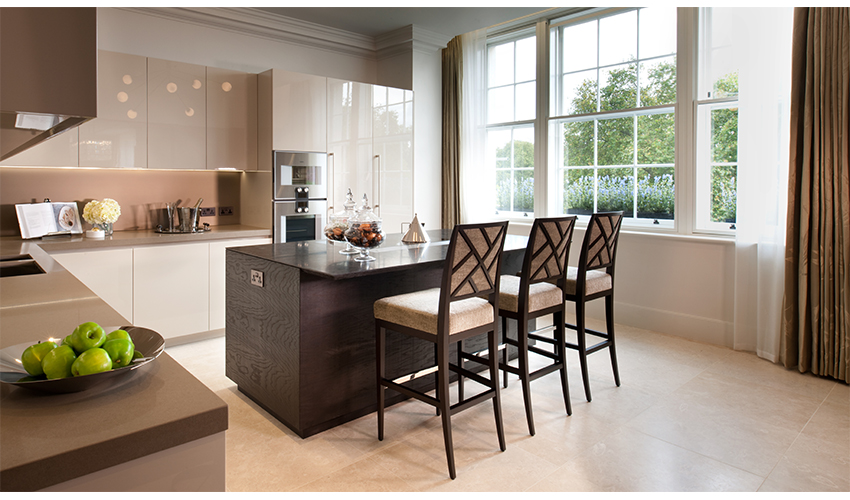With so many Listed buildings across the UK requiring interventions to bring them up to 21st century standards; one quick win, with three beneficial outcomes, is to install secondary glazing. By retrofitting an internal window, in effect creating double glazing, you will almost eliminate draughts and heat loss, provide noise insulation and give an added layer of security at the windows.
 Warmer, quieter and safer benefits of secondary glazing
Although secondary glazing is a minimal intervention, Listed Building Consent should always be sought. In most instances it is accepted and is generally the only way to raise the window performance in Listed and heritage buildings due to the restrictions posed on them to retain and preserve details of historical and architectural interest.
However, we have found that the level of acceptance for the use of secondary glazing varies across the UK from one conservation office to another and from one architect to another – sometimes for subjective reasons based on personal taste and aesthetic preferences. Often with no other means of raising the window efficiency, secondary glazing presents the only option; so when faced with questions or objections to its installation in a project, we would refer designers and clients to a useful publication written by Historic England when working with them; Energy Efficiency and Historic Buildings: Secondary Glazing for Windows
Warmer, quieter and safer benefits of secondary glazing
Although secondary glazing is a minimal intervention, Listed Building Consent should always be sought. In most instances it is accepted and is generally the only way to raise the window performance in Listed and heritage buildings due to the restrictions posed on them to retain and preserve details of historical and architectural interest.
However, we have found that the level of acceptance for the use of secondary glazing varies across the UK from one conservation office to another and from one architect to another – sometimes for subjective reasons based on personal taste and aesthetic preferences. Often with no other means of raising the window efficiency, secondary glazing presents the only option; so when faced with questions or objections to its installation in a project, we would refer designers and clients to a useful publication written by Historic England when working with them; Energy Efficiency and Historic Buildings: Secondary Glazing for Windows
 Energy Efficiency and HIstoric Buildings - Secondary glazing in John Street
The following are a few points we are often raised and our responses, which may help you with any queries you have about the use of secondary glazing.
What is the physical impact of installing secondary glazing on the building fabric?
It is a reversible adaptation that tries to avoid impacting the historic building fabric and any surrounding decorations. The method of fixing we use is to create timber sub frames which are fixed into the window reveal and the secondary glazing frame fitted into this. If in the future, the windows need to be returned to their original state, then a minimal amount of making good and decorating will be required.
Please note: Impacts are usually unavoidable when Listed buildings require enhanced security to mitigate against blast or intruder. The historic window surrounds may need to be strengthened to ensure the integrity of the treatment. This could mean removal of the surrounds to allow the insertion of steel or timber reinforcements back to the structure and then the original fabric reinstated. This allows through fixing of the secure secondary window into the reinforcement. The professional team will include risk assessors, security and blast consultants, structural engineers and heritage architects.
Energy Efficiency and HIstoric Buildings - Secondary glazing in John Street
The following are a few points we are often raised and our responses, which may help you with any queries you have about the use of secondary glazing.
What is the physical impact of installing secondary glazing on the building fabric?
It is a reversible adaptation that tries to avoid impacting the historic building fabric and any surrounding decorations. The method of fixing we use is to create timber sub frames which are fixed into the window reveal and the secondary glazing frame fitted into this. If in the future, the windows need to be returned to their original state, then a minimal amount of making good and decorating will be required.
Please note: Impacts are usually unavoidable when Listed buildings require enhanced security to mitigate against blast or intruder. The historic window surrounds may need to be strengthened to ensure the integrity of the treatment. This could mean removal of the surrounds to allow the insertion of steel or timber reinforcements back to the structure and then the original fabric reinstated. This allows through fixing of the secure secondary window into the reinforcement. The professional team will include risk assessors, security and blast consultants, structural engineers and heritage architects.
 Adding reinforcements to existing reveal to meet security specification
Will it have a visual impact on the window surrounds
The choice of profiles and frame style configurations should be in keeping with the design and materials of the room. Clear sightlines should be maintained providing an uninterrupted view from the window where possible.
Adding reinforcements to existing reveal to meet security specification
Will it have a visual impact on the window surrounds
The choice of profiles and frame style configurations should be in keeping with the design and materials of the room. Clear sightlines should be maintained providing an uninterrupted view from the window where possible.
 Low visual impact of heritage secondary glazing
Low visual impact of heritage secondary glazing
 Warmer, quieter and safer benefits of secondary glazing
Although secondary glazing is a minimal intervention, Listed Building Consent should always be sought. In most instances it is accepted and is generally the only way to raise the window performance in Listed and heritage buildings due to the restrictions posed on them to retain and preserve details of historical and architectural interest.
However, we have found that the level of acceptance for the use of secondary glazing varies across the UK from one conservation office to another and from one architect to another – sometimes for subjective reasons based on personal taste and aesthetic preferences. Often with no other means of raising the window efficiency, secondary glazing presents the only option; so when faced with questions or objections to its installation in a project, we would refer designers and clients to a useful publication written by Historic England when working with them; Energy Efficiency and Historic Buildings: Secondary Glazing for Windows
Warmer, quieter and safer benefits of secondary glazing
Although secondary glazing is a minimal intervention, Listed Building Consent should always be sought. In most instances it is accepted and is generally the only way to raise the window performance in Listed and heritage buildings due to the restrictions posed on them to retain and preserve details of historical and architectural interest.
However, we have found that the level of acceptance for the use of secondary glazing varies across the UK from one conservation office to another and from one architect to another – sometimes for subjective reasons based on personal taste and aesthetic preferences. Often with no other means of raising the window efficiency, secondary glazing presents the only option; so when faced with questions or objections to its installation in a project, we would refer designers and clients to a useful publication written by Historic England when working with them; Energy Efficiency and Historic Buildings: Secondary Glazing for Windows
 Energy Efficiency and HIstoric Buildings - Secondary glazing in John Street
The following are a few points we are often raised and our responses, which may help you with any queries you have about the use of secondary glazing.
What is the physical impact of installing secondary glazing on the building fabric?
It is a reversible adaptation that tries to avoid impacting the historic building fabric and any surrounding decorations. The method of fixing we use is to create timber sub frames which are fixed into the window reveal and the secondary glazing frame fitted into this. If in the future, the windows need to be returned to their original state, then a minimal amount of making good and decorating will be required.
Please note: Impacts are usually unavoidable when Listed buildings require enhanced security to mitigate against blast or intruder. The historic window surrounds may need to be strengthened to ensure the integrity of the treatment. This could mean removal of the surrounds to allow the insertion of steel or timber reinforcements back to the structure and then the original fabric reinstated. This allows through fixing of the secure secondary window into the reinforcement. The professional team will include risk assessors, security and blast consultants, structural engineers and heritage architects.
Energy Efficiency and HIstoric Buildings - Secondary glazing in John Street
The following are a few points we are often raised and our responses, which may help you with any queries you have about the use of secondary glazing.
What is the physical impact of installing secondary glazing on the building fabric?
It is a reversible adaptation that tries to avoid impacting the historic building fabric and any surrounding decorations. The method of fixing we use is to create timber sub frames which are fixed into the window reveal and the secondary glazing frame fitted into this. If in the future, the windows need to be returned to their original state, then a minimal amount of making good and decorating will be required.
Please note: Impacts are usually unavoidable when Listed buildings require enhanced security to mitigate against blast or intruder. The historic window surrounds may need to be strengthened to ensure the integrity of the treatment. This could mean removal of the surrounds to allow the insertion of steel or timber reinforcements back to the structure and then the original fabric reinstated. This allows through fixing of the secure secondary window into the reinforcement. The professional team will include risk assessors, security and blast consultants, structural engineers and heritage architects.
 Adding reinforcements to existing reveal to meet security specification
Will it have a visual impact on the window surrounds
The choice of profiles and frame style configurations should be in keeping with the design and materials of the room. Clear sightlines should be maintained providing an uninterrupted view from the window where possible.
Adding reinforcements to existing reveal to meet security specification
Will it have a visual impact on the window surrounds
The choice of profiles and frame style configurations should be in keeping with the design and materials of the room. Clear sightlines should be maintained providing an uninterrupted view from the window where possible.
 Low visual impact of heritage secondary glazing
Low visual impact of heritage secondary glazing - Date
- Category
- Secondary Glazing in Practice